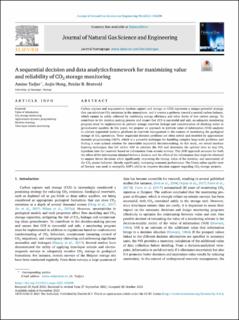| dc.contributor.author | Tadjer, Mohamed Amine Amazigh | |
| dc.contributor.author | Hong, Aojie | |
| dc.contributor.author | Bratvold, Reidar Brumer | |
| dc.date.accessioned | 2021-11-13T13:03:57Z | |
| dc.date.available | 2021-11-13T13:03:57Z | |
| dc.date.created | 2021-11-06T12:05:35Z | |
| dc.date.issued | 2021-12 | |
| dc.identifier.citation | Tadjer, A., Hong, A., Bratvold, R.B. (2021) A sequential decision and data analytics framework for maximizing value and reliability of CO2 storage monitoring. Journal of Natural Gas Science and Engineering, 96, 104298 | en_US |
| dc.identifier.issn | 1875-5100 | |
| dc.identifier.uri | https://hdl.handle.net/11250/2829436 | |
| dc.description.abstract | Carbon capture and sequestration (carbon capture and storage or CCS) represents a unique potential strategy that can minimize CO2 emissions in the atmosphere, and it creates a pathway toward a neutral carbon balance, which cannot be solely achieved by combining energy efficiency and other forms of low carbon energy. To contribute to the decision-making process and ensure that CCS is successful and safe, an adequate monitoring program must be implemented to prevent storage reservoir leakage and contamination of drinking water in groundwater aquifers. In this paper, we propose an approach to perform value of information (VOI) analyses to address sequential decision problems in reservoir management in the context of monitoring the geological storage of CO2 operations. These sequential decision problems are often solved and modeled by approximate dynamic programming (ADP), which is a powerful technique for handling complex large-scale problems and finding a near-optimal solution for intractable sequential decision-making. In this study, we tested machine learning techniques that fall within ADP to estimate the VOI and determine the optimal time to stop CO2 injections into the reservoir based on information from seismic surveys. This ADP approach accounts for both the effect of the information obtained before a decision and the effect of the information that might be obtained to support future decisions while significantly improving the timing, value of the decision, and uncertainty of the CO2 plume behavior, thereby significantly increasing economic performance. The Utsira saline aquifer west of Norway was used to exemplify ADP’s ability to improve decision support regarding CO2 storage projects. | en_US |
| dc.language.iso | eng | en_US |
| dc.publisher | Elsevier Ltd. | en_US |
| dc.rights | Navngivelse 4.0 Internasjonal | * |
| dc.rights.uri | http://creativecommons.org/licenses/by/4.0/deed.no | * |
| dc.subject | olje og gass | en_US |
| dc.subject | karbonfangst | en_US |
| dc.subject | co2-utslipp | en_US |
| dc.title | A sequential decision and data analytics framework for maximizing value and reliability of CO2 storage monitoring | en_US |
| dc.type | Peer reviewed | en_US |
| dc.type | Journal article | en_US |
| dc.description.version | publishedVersion | en_US |
| dc.rights.holder | © 2021 The Authors | en_US |
| dc.subject.nsi | VDP::Teknologi: 500::Berg‑ og petroleumsfag: 510 | en_US |
| dc.source.volume | 96 | en_US |
| dc.source.journal | Journal of Natural Gas Science and Engineering | en_US |
| dc.identifier.doi | 10.1016/j.jngse.2021.104298 | |
| dc.identifier.cristin | 1952020 | |
| dc.relation.project | Norges forskningsråd: 280473 | en_US |
| dc.source.articlenumber | 104298 | en_US |
| cristin.ispublished | true | |
| cristin.fulltext | original | |
| cristin.qualitycode | 1 | |

